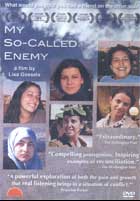
My So-Called Enemy: A Film by Lisa Gossels 2010
Distributed by New Day Films, 190 Route 17M, P.O. Box 1084, Harriman, NY 10926; 888-367-9154 or 845-774-7051
Produced by Lisa Gossels & Eden Wurmfeld; Good Egg Productions
Directed by Lisa Gossels
DVD, color, 89 min.
Sr. High - General Adult
Israel, Palestine, Arab-Israeli Conflict
Date Entered: 07/18/2014
Reviewed by Sheila Intner, Professor Emerita, Graduate School of Library & Information Science, Simmons College GSLIS at Mt. Holyoke, South Hadley, MAComplete subtitles would make this documentary an absolutely must-see film for everyone—students and members of the general public alike—having any kind of interest in Israel, Israeli-Palestinian issues, and Middle-East peace. As it is, the subtitling in this fascinating film about six Israeli and Palestinian young women who participate in a peace program called Building Bridges for Peace (BBfP) seems haphazard. Sometimes subtitles appear when the teens speak English and sometimes—though not always—when they speak Hebrew and Arabic. Occasionally, subtitles are absent during the non-English conversation, but, because of their heavy accents, subtitles would be welcome even when English is spoken. That said, the rest of what this reviewer has to say about the film is that it is outstanding.
Two of the six teens are Jewish Israelis—Gal and Adi; two are Palestinian Christians—Rezan and Inas; and two are Palestinian Muslims—Rawan and Hanin. Footage begins in 2002, when the six girls fly to the U.S. for the larger BBfP camping program in Bridgeton, New Jersey. The camera follows them in discussions, games, shopping, sports, and downtime activities. The Jewish teens hear the frustration expressed by the Palestinians, but try to explain their right to the state of Israel. They are visibly shaken by the anger and commitment the Palestinians have to reclaiming what they believe is their land. The Palestinian teens find themselves moved by the profound feelings for the land expressed by the Jewish girls. Each begins to see the others differently, as individuals grappling with similar aspirations, difficulties, and fears. Each girl experiences unexpected emotions and gains a new understanding of the people she had been categorizing as enemies.
After the girls return home, the filmmaker continues to portray highlights of their daily lives, interactions with their families, and reunions with the BBfP participants. The follow-up continues through 2009. Throughout the film, archival footage of events that occurred in Israel and the Palestinian Territories appear. Viewers observe the continuing friendship of Gal and Rezan, the peace-promoting activities in which several of the girls engage, and other ways in which the BBfP experience has impacted their lives. Gal and Adi perform their compulsory military service. Inas cannot bear life in her native country and she moves to Chicago, Illinois. Hanin becomes intensely religious, still believing that peace is a paramount goal of Islam.
For the most part, the technical aspects of the film are excellent. Good camera work, editing, and excellent pacing work together to create a smooth product that captures viewers’ attention and never flags. With some exceptions, the film does a satisfying job of reflecting the array of events during the BBfP camp in the U.S. and, then, the important aspects of the girls’ lives over the seven years that follow. The only drawback, as already pointed out, is the lack of complete and consistent subtitles so viewers do not miss a single word being said.